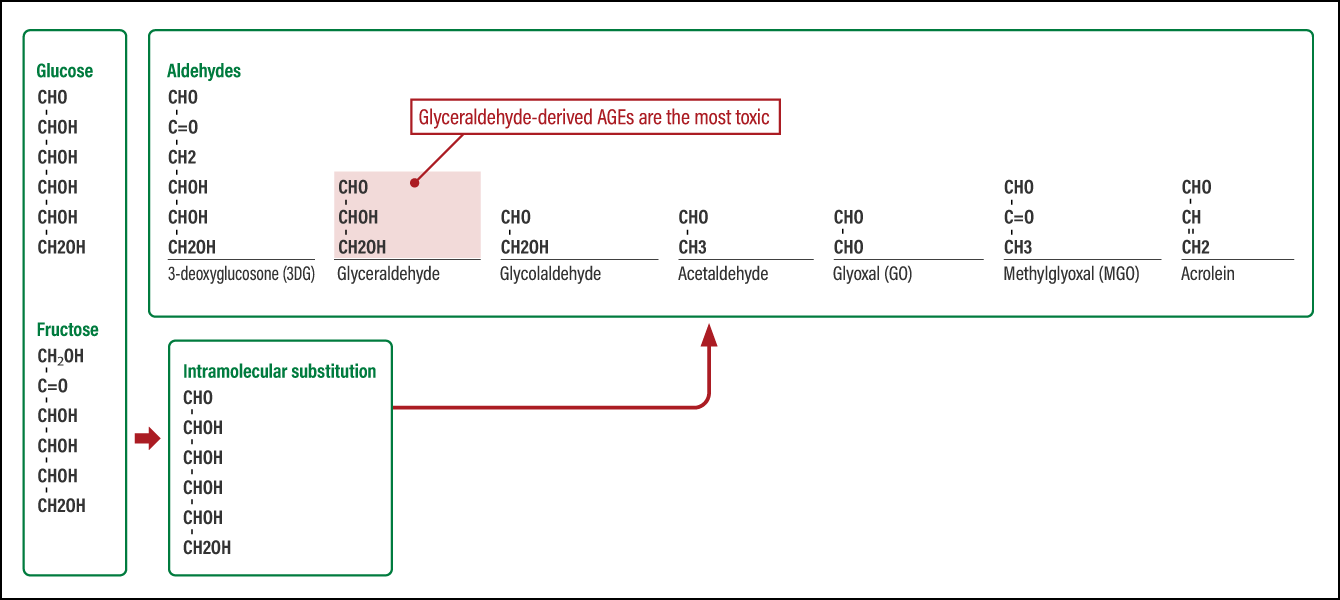Stress is known to be the cause of various diseases, but it can also be a factor contributing to earlier onset of aging. One of several types of stress, glycative stress has come under the spotlight in recent years. Glycation is a phenomenon in which proteins in the body bond with leftover sugar due to excessive consumption and degrade, producing advanced glycation end products (AGEs), which expedite aging. The buildup of AGEs has an adverse impact on the body, as it is a risk factor for such conditions as dementia, diabetes, and arteriosclerosis. The only way to avoid this is, as one might expect, to ensure our sugar consumption remains at appropriate levels, and scientists say that what we eat, when we eat it, and how much we eat are crucial.
Special Feature 1 – Focus on Sugars Appropriate sugar intake to protect the body against the aging effects of glycation
composition by Takeaki Kikuchi
Five risk factors expedite aging: (1) immune stress; (2) oxidative stress; (3) physical and mental stress; (4) lifestyle; and (5) glycative stress. Especially crucial among these are oxidative stress and glycative stress.
Sugar causes proteins to “burn”
Oxidative stress has already been the subject of numerous studies. While oxidation has substantial adverse effects on human health, humans have developed an antioxidant system over the millennia. Vitamins C and E are important in halting oxidation, and the blood concentration of these vitamins in humans is higher than in other animals. This is one reason for human longevity.
Glycative stress is a much newer concept. The risks of glycative stress were first identified no more than 50 years ago. This is thought to be because modern humans have become exposed to glycative stress, due to dietary changes accompanying economic development and a sharp fall in exercise levels resulting from increasingly advanced modes of transport and electrical appliances. Vitamins C and E are ineffective against this kind of stress.
Glycation is an excessive buildup of proteins that have been glycated, resulting from the bonding of proteins in the body with sugar consumed in the diet. Glycated proteins ultimately produce substances called advanced glycation end products (AGEs), which expedite aging.
Glycation was first discovered as a result of research into a reaction that occurs in food. The study was published in 1912 by French chemist Louis-Camille Maillard and the reaction became known as the Maillard reaction. Pancakes start off as a white paste, but when you put the mixture into a frying pan and apply heat, the protein in the flour gradually turns golden brown.
In our bodies, sugar causes proteins to “burn” in a similar way. While the human body does not undergo rapid temperature rises in the same way as a frying pan when heated, the proteins and sugar are warmed by our body temperature of 36-37°C over a long period.
The vast majority of AGEs in food are good for our health. Melanoidins are a prime example of good AGEs, which have antioxidant effects. The soy protein found in miso and soy sauce causes a Maillard reaction that produces melanoidins. Not only are they good for our health, but they also improve aroma and flavor. In contrast, the AGEs produced in our bodies are all bad for us. This is because glycative stress in the body is not the same as the Maillard reaction in food. Unlike in food, the key features of the glycation process in the body are: (1) a short reaction time; (2) the protagonist is not glucose; (3) complexity in terms of the reaction produced under a diverse array of conditions in the blood, interstitial fluid, and cells, among others; and (4) induction of inflammation.
The adverse impact of glycative stress on the body
With regard to (2) above, aldehydes are the primary actor. The chemical formula of glucose is C6H12O6, which means it has six carbon (C) atoms. Fructose is the same. In at least 99% of cases, they occur in cyclic (ring) form. However, when subjected to heat, ultraviolet rays, oxidative stress, or attack by other aldehydes, their configuration collapses into shreds, forming aldehydes.
The term “glucose spike” has become the focus of attention in recent years. It refers to a sharp rise in blood glucose levels after eating. There is no clear definition, but it would be fair to describe a rise in blood glucose level to above 140 mg/dl after eating as a glucose spike.
A glucose spike triggers the production of large quantities of various aldehydes in a chain reaction. This is known as an aldehyde spark. In 2015, an experiment was conducted in Germany, in which subjects consumed glucose to raise their blood glucose level. The results showed an increase in the concentration of glucose in their blood (blood glucose level), along with the production of the sugar-derived aldehydes glyoxal (GO), methylglyoxal (MGO), and 3-deoxyglucosone (3DG). Aldehydes are highly reactive with protein, bonding with them to form protein carbonyls, which go on to become AGEs if this process progresses. Of the aldehydes, AGEs derived from glyceraldehyde are the most toxic (Figure 1).

Figure 1. Various sugar-derived aldehydes are formed in the human bodyGlucose and fructose are expressed with the chemical formula C6H12O6. When exposed to heat, ultraviolet rays or the like, this configuration collapses, forming various aldehydes.
Moreover, glycative stress has various adverse impacts on the body (Figure 2).

Figure 2. Impact of glycative stress on the bodyGlycative stress is the cause of various forms of aging, including dementia, arteriosclerosis, cataracts, and age-related macular degeneration.
Take dementia, for example. In the case of Alzheimer’s disease, the glycation of amyloid beta and tau protein has negative effects. Amyloid beta is said to cause Alzheimer’s disease, but rather than the amyloid beta itself, it is glycated amyloid beta that is the culprit. Amyloid beta is broken down by enzymes and cleared from the brain. However, glycated amyloid beta is hard to break down, because it clumps together, amplifying its neurotoxic properties. Even enzymes cannot break it down, making it hard to clear.
Low-density lipoprotein (LDL) cholesterol is a risk factor for arteriosclerosis; it is thought that the problem is actually modified (abnormal) LDL cholesterol, which is formed when LDL cholesterol becomes oxidized and glycated. When modified LDL cholesterol is produced, white blood cells called macrophages consume it in a process called phagocytosis. When they have completed the phagocytosis process, the macrophages form foam cells, which are deposited on the vascular wall, causing arteriosclerosis to progress.
In the case of eyes, the glycation-induced clouding of proteins called crystallins is involved in the formation of cataracts. There is also a condition called age-related macular degeneration, which is caused by a buildup of deposits called drusen on the retina —— this, too, is the result of glycated and oxidized proteins.
Protein makes up a third of bone by mass. When this protein is glycated, bones become more prone to breaking. In joints, osteoarthritis is caused by glycation of the cartilage matrix protein proteoglycan, which serves as a cushion. Glycation of the collagen in skin leads to cross-link formation, causing collagen fibers to harden, while the buildup of AGEs in the skin results in it taking on a yellow, sallow appearance.
What should we eat and how?
It would be no exaggeration to describe this as the age of battling glycative stress. The measures required to combat this are (1) minimizing glucose spikes and alleviating aldehyde sparks; and (2) curbing the production of AGEs and encouraging their breakdown. Research into effective dietary approaches to addressing glycative stress has progressed.
Of course, all foods cause blood glucose levels to rise after consumption. However, some trigger a sharp rise, while others elevate it more gradually. Nevertheless, it is not very practical to eat only foods that elevate blood glucose levels gradually. Accordingly, what I would suggest to readers is to focus on the PFC balance. The ideal balance of protein, fat, and carbohydrates is said to be 2:2:6. This is calculated on a calorie basis. For example, if consuming 2,000 kcal per day, you should consume 400 kcal of protein, 400 kcal of fat, and 1,200 kcal of carbohydrates.
It is surprisingly difficult to consume 400 kcal of protein. 1 g of protein is 4 kcal, which means you need to consume 100 g of protein per day, but this is actually very hard. For example, the protein content of 100 g of wagyu beef thigh (red meat) is about 23 g, so if you were going to obtain your daily requirement from beef alone, you would need to eat as much as 476 g to consume 100 g of protein. As this is tricky, we need to take care to consume protein from foods other than beef as well. One pack of natto (fermented soybeans) contains 6-7 g of protein, while 100 g of cooked white rice contains 2-3 g.
A recent study revealed that maintaining a high concentration of amino acids in the blood is key to alleviating aldehyde sparks. Eating plenty of meat, fish, soybeans, and dairy products is important in this regard. When elderly people eat lunch at a soba noodle restaurant, for example, they tend to order dishes consisting of soba or udon noodles and soup alone, without any protein or vegetables, but the risk of an aldehyde spark can be reduced simply by switching to a dish such as tsukimi-soba or tsukimi-udon, in which the noodles are topped with an egg. I have personal experience of this. I regularly measure the AGEs level in my skin. There was a period when I was so busy I did not have time to eat proper meals and lived on snack breads that I bought from convenience stores. My AGEs level was much higher than normal at that time. The fact that my diet was overly carbohydrate-heavy was evident from the figures. Accordingly, I switched from snack breads to protein bars, and my ACEs figures improved considerably.
I would like to draw your attention to a couple of foods for their ability to slow the absorption of sugar to a more gradual pace: vinegar and foods with a slimy texture. The slimy component in foods such as natto, okra, yamaimo (mountain yam), and the seaweeds mekabu (the flowering sprouts of wakame) and mozuku (brown algae) is a mixture of glycoproteins, which are proteins bonded with polysaccharides. If you eat foods rich in this component along with sugar, the component coats the sugar, which slows its absorption to a more gradual pace. Vinegar, meanwhile, contains a great deal of acetic acid. We know that the postprandial rise in blood glucose level is more moderate if a tablespoon of vinegar is consumed along with one’s meal. Citrus fruit such as lemons contain a lot of citric acid. One effect of citric acid is to activate the tricarboxylic acid (TCA) cycle, which is responsible for metabolizing glucose, thereby progressively consuming glucose.
Taking a supplement that inhibits the action of the enzyme alpha-glucosidase is also effective in curbing glucose spikes. The active ingredient is contained in a plant called Salacia and also in mulberry leaf extract. The carbohydrates in food are broken down into disaccharides by an enzyme called alpha-amylase. Alpha-glucosidase then breaks these disaccharides down into glucose. Slowing their breakdown into glucose by inhibiting the action of alpha-glucosidase results in a more gradual rise in postprandial blood glucose levels.
A diet based on one meal a day has only negative effects
In addition to what we eat, when we eat is also crucial.
The most important point is to eat a proper breakfast (Figure 3). In our research, we have found that eating a proper breakfast means that blood glucose levels are less inclined to rise after lunch. To put it another way, people who do not eat breakfast are more prone to a glucose spike after lunch. We have also discovered that it is advisable to eat not only carbohydrates such as rice or bread, but also a generous quantity of side dishes, especially those containing protein.

Figure 3. Blood glucose and hormone fluctuations after skipping breakfastFailing to eat breakfast causes blood glucose levels to rise sharply after lunch and dinner, and also increases the quantity of insulin and glucagon secreted, thereby increasing the burden on the pancreas.
In terms of the number of meals consumed, one popular eating regime is the one meal a day (OMAD) diet. Under the OMAD diet, dieters skip breakfast and lunch, and eat only dinner. Many people seem to be attracted to it by the way it is explained: “Cut your meals back to just one a day. But then you can eat anything you like for dinner.” However, from the perspective of glycation in the body, this has only negative effects. Conversely, eating smaller meals more frequently —— say, four or five times a day —— is no better. This is because it has an adverse impact on growth hormones involved in the metabolism of fat and sugar. To produce growth hormones, it is best to eat only after one’s stomach is empty.
In addition to taking care to get into the habit of eating three meals a day, it is advisable when you eat your meal to adopt the “veggies first” approach. In other words, you should start by eating your vegetables first. Also important is eating slowly, chewing your food well. Even if the amount of sugar consumed is the same, chewing food thoroughly ensures it is digested and absorbed more gradually, slowing the time it takes to be absorbed in the small intestine and enter the blood.
Next, allow me to explain how to curb the production of AGEs and speed up their breakdown.
The first thing I would recommend is tea. The catechins in tea are effective. In particular, as well as tea itself, herbal teas also contain many components that are effective in suppressing production of AGEs. At my laboratory, we assembled a collection of around 200 types of tea and analyzed their components. We investigated whether they inhibited the collagen glycation effect. As a result, we discovered that chamomile tea, dokudami (Houttuynia cordata Thunb) tea, persimmon leaf tea, tencha (Chinese sweet tea), guava tea, shiso (Japanese perilla) tea, and rooibos tea are rich in active ingredients.
Attention is also focusing on dietary fiber in vegetables and the like. In the intestines, dietary fiber produces short-chain fatty acids in the form of butyric acid, propionic acid, and acetic acid, which alter the gut microbiota and promote good bowel movements. Another effect of short-chain fatty acids is to suppress the production of AGEs and expedite their breakdown. Miso is also important. In the fermentation process that produces soybean miso, the isoflavones contained in soybeans are hydroxylated and converted into dihydroxyisoflavones. Scientists have discovered that not only do they have a stronger antioxidant action than unconverted isoflavones, but they also have a powerful antiglycation effect.
To slow down the aging process and stay healthy, it is important to adopt a diet that takes into account measures to combat glycation.




















